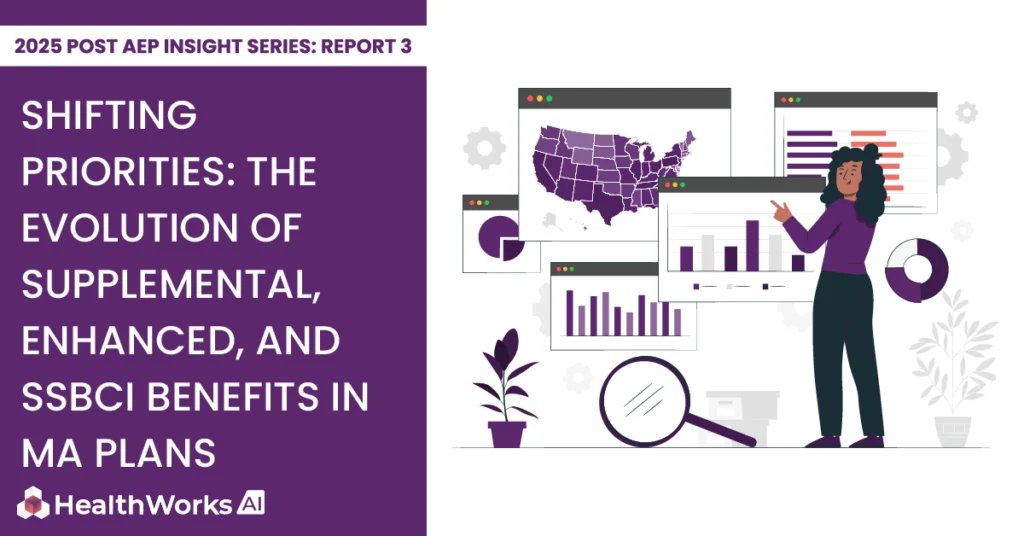2025 Post AEP Insight Series: Report 2 📊
Strategic Inflection in Special Needs Plans: C-SNP Momentum vs. D-SNP Maturity
2025 Medicare Advantage SNP trends: C-SNPs surge with 21.4% plan growth, D-SNPs stabilize. Insights on enrollment, premiums, and payor strategies for 2026 bids.
April 28, 2025 Market Research

Table of Contents
Introduction
In the last five years, Special Needs Plans (SNPs) have seen substantial enrollment gains, yet this growth conceals distinct paths within the segment. Dual Eligible Special Needs Plans (D-SNPs) have largely stabilized after years of predominance, whereas Chronic Condition Special Needs Plans (C-SNPs) have surged, propelled by strategic risk management, supportive regulations, and a focus on condition-specific treatment frameworks. This report delves into national and state-level dynamics, changes in plan structures, premium fluctuations, and payer-specific trends, providing an in-depth perspective on the SNP market’s trajectory in 2025 and its implications for the forthcoming bidding period. Drawing from Centers for Medicare & Medicaid Services (CMS) data, the analysis identifies the factors influencing these trends and offers practical insights to inform future strategies.
National Overview
National Trends:
- C-SNPs: Plan numbers rose by 21.4% annually (322 to 391); enrollment has more than tripled since 2021, reaching 1.09 million.
- D-SNPs: Slower growth with just an 8% increase in plan numbers (875 to 945); net enrollment gains significantly dropped (162K to 46K).
- C-SNPs’ share of total Medicare Advantage enrollment increased from 2.4% to 3.8%; D-SNPs maintained a steady ~21%.
By 2025, SNPs had expanded notably, particularly within C-SNPs and D-SNPs. C-SNP plans increased from 322 in 2024 to 391 in 2025, marking a 21.4% rise, especially significant against the previous year’s modest 1.9% growth. D-SNP plans, however, continued to grow at a slower rate, increasing from 875 to 945 in 2025, an 8% rise, indicating a slight year-over-year growth reduction.
This growth in plan availability was accompanied by robust enrollment increases. C-SNP enrollment nearly tripled, from 384,641 in 2021 to over 1.09 million by 2025. D-SNPs also saw substantial growth, doubling from 3.33 million to 6.02 million members in the same period. Among total Medicare Advantage beneficiaries, C-SNPs’ share grew from 2.4% in 2024 to 3.8% in 2025, while D-SNPs held a consistent 21% share across both years.
Net enrollment trends highlight C-SNPs as entering a rapid growth phase, with gains more than doubling from approximately 111,958 in 2024 to over 223,124 in 2025. In contrast, while D-SNPs continue to expand, their pace appears to be slowing, with net enrollment gains dropping significantly from 162,125 to just 46,409 currently. This divergence suggests D-SNPs might be nearing market saturation, whereas C-SNPs are emerging as a major growth driver within the Medicare Advantage framework.
State Overview
State Trends:
- Florida led in both C-SNP and D-SNP plan and enrollment growth.
- Texas and California posted significant C-SNP increases.
- States like New York and Tennessee experienced net losses in D-SNP enrollment.
- Smaller states such as Tennessee and North Carolina showed the highest C-SNP growth rates by percentage.
Florida continues to lead the landscape in 2025, offering the most C-SNP and D-SNP plans, with 84 and 114 respectively. Among states showing considerable growth in C-SNP availability, Tennessee saw the largest increase with nine additional plans, followed by Illinois with six. C-SNP declines were minimal, limited to three states—Nevada (-3), Missouri (-1), and Wisconsin (-1). In D-SNPs, Puerto Rico and Washington had the most significant expansions, each adding ten new plans, bringing their totals to 36 and 26, respectively.
SNP enrollment continued its upward trajectory, propelled by targeted C-SNP expansions and steady D-SNP momentum. Florida leads the nation in absolute C-SNP enrollment increases, rising from about 126,255 in 2024 to over 195,436 in 2025—a 55% year-over-year enrollment hike. Similarly, Texas and California experienced substantial growth, adding 48,059 and 38,816 enrollees, respectively. Meanwhile, traditionally lower-enrollment states like Tennessee, North Carolina, and Alabama posted notable percentage increases, with Tennessee jumping from 5,494 lives in 2024 to over 27,165 in 2025. D-SNP enrollment maintained a strong yet slightly variable growth pattern. North Carolina stood out, nearly doubling its D-SNP membership from about 119,612 in 2023 to over 221,262 in 2025. California and Florida added 33,889 and 16,605 new D-SNP members, respectively, with Florida continuing to lead nationally at 679,632 enrollees. However, a few states—notably Tennessee and Georgia—saw marginal declines in D-SNP enrollment, dropping by 4,467 and 4,330, respectively, in 2025.
In terms of net C-SNP enrollment, Florida again leads with a gain of 34,639 enrollees, followed by California (20,290) and Texas (18,906). States like Ohio (+13,475) and Georgia (+9,265) also made strong recoveries after previous declines. Conversely, states such as Mississippi (-4,137) and New Mexico (-1,541) recorded noticeable drops in net C-SNP enrollment, indicating regional shifts in competitiveness or changes in eligibility dynamics.
For D-SNPs, the trend shows a more mixed picture. After several years of consistent growth, New York experienced a significant reversal in 2025, losing 30,687 beneficiaries—its largest net decline to date. Meanwhile, despite maintaining a positive net enrollment trajectory, California experienced a sharp slowdown, dropping from a peak gain of 180,096 enrollees in 2023 to just 14,788 in 2025. Similarly, Florida, which posted the second-highest net gain in 2024, added only 1,503 enrollees in 2025, indicating a clear deceleration in momentum.
Plan Type Overview
Plan Type Trends
- Growth driven by Local HMOs and PPOs in both SNP types.
- Regional PPOs declined, especially in D-SNPs.
- C-SNP Local HMOs saw 81% YoY enrollment growth.
- D-SNP Local PPOs and HMOs plateaued, even turning negative in some segments.
In 2025, C-SNP and D-SNP plans grew, led by substantial increases in Local HMO (C-SNP: +56; D-SNP: +46) and Local PPO plans (C-SNP: +13; D-SNP: +25). This reflects continued issuer expansion in localized markets. Meanwhile, Regional PPOs stagnated in C-SNPs and declined in D-SNPs, dropping to just two plans, signaling reduced emphasis on broad-network offerings.
Enrollment growth remained robust in C-SNP Local HMOs, doubling from 440,689 in 2024 to 796,944 in 2025, an 80.84% YoY increase, indicating aggressive expansion and strong beneficiary uptake. C-SNP Local PPOs also grew significantly from 164,121 to 264,976 (up 61.45%). In contrast, Regional PPO enrollment continued to decline, dropping to 35,050 in 2025, reinforcing the shift toward more localized plan structures. For D-SNPs, growth momentum slowed. Local HMO enrollment grew marginally by 4.19% YoY, from 4.76 million to 4.96 million, and Local PPOs saw a similar plateau, rising just 2.41%. The decline in Regional PPO enrollment continued, falling to 16,587 in 2025 from 22,477 in 2024.
C-SNPs saw strong gains in 2025, particularly in Local HMOs, where average net enrollment per plan more than doubled from 84,006 in 2024 to 195,128. Local PPOs dipped slightly from 49,523 to 33,050, while Regional PPOs, though still negative, showed improvement from -21,571 to -5,054, indicating reduced losses. In contrast, D-SNPs experienced a sharp slowdown. Local HMOs dropped from 102,725 to 53,154, and Local PPOs turned negative, falling to -5,714, marking their first net loss in recent years. Regional PPOs continued their decline, reaching -1,031, showing persistent disengagement from wide-area plan offerings.
Premium Overview
Premium Trends
- $0 premium plans dominate: C-SNP (83% of enrollment); D-SNP (78%, up from 71% in 2024).
- Mid-tier premium categories ($25–$50) gained traction in C-SNPs but collapsed in D-SNPs
$0 premium plans continued to lead the C-SNP and D-SNP markets in 2025, highlighting the ongoing shift toward affordability. In the C-SNP space, $0 premium plans rose from 244 to 309, with enrollment jumping 74.7% YoY to over 910,293, representing 83% of total C-SNP enrollment. This growth came alongside a steady decline in mid-tier premium plans. While the >$0 to <=$25 segment saw a slight increase in plan count (from 36 to 39), enrollment declined by 10.4%. Notably, the >$25 to <=$50 premium bracket added 64,340 beneficiaries to reach 96,529 across just 38 plans, highlighting the growing interest in this range despite its limited availability. In contrast, premium bands above $50 continued their downward spiral, now representing less than 0.1% of enrollment share.
In the D-SNP space, the shift was even more pronounced. $0 premium enrollments rose to 4.68 million in 2025, reflecting a 14% YoY jump and now representing nearly 78% of all D-SNP enrollment, up from just 71% in 2024. Higher premium tiers like >$25 to <=$50 saw the steepest fall, both in enrollment (down 58%) and plan count (cut nearly in half). The mid-range >$0 to <=$25 segment rebounded with a 337,701 enrollment spike, though it still occupies a smaller share than the 2023 levels.
Drug Overview
Drug Deductibles Trends
- C-SNPs shifted heavily to >$100 deductibles (now 65% of total).
- D-SNPs remained stable with high-deductible dominance (99%+), but $0 deductibles re-entered modestly
Both C-SNP and D-SNP markets saw a continued shift toward higher drug deductibles in 2025. C-SNP plans with over $100 deductibles more than doubled from 92 to 205, while $0 deductible plans declined from 228 to 184, highlighting a growing preference for higher cost-sharing. Similarly, high-deductible plans rose from 875 to 943 in the D-SNP space, maintaining their dominance. Meanwhile, $0 deductible D-SNP plans remained scarce, with only two offerings available, unchanged from 2024.
In the C-SNP market, 2025 marked a significant shift toward higher drug deductibles. The Over $100 deductible category experienced explosive growth, surging to 718,636 enrollees, now comprising over 65% of total C-SNP enrollment. This sharp rise contrasts with the steep decline in $0 deductible plans, which dropped 23.4% YoY to 375,480 enrollees, reducing their share from nearly 75% in 2024 to just 34% in 2025. While the >$50 to <=$100 deductible segment remained a small slice of the market, it saw steady growth of 55% YoY, indicating some shift toward moderate-cost-sharing options. On the other hand, the >$25 to <=$50 deductible bracket disappeared entirely in 2025, signaling its complete exit from the market.
The D-SNP landscape remained largely consistent, with Over $100 deductible plans continuing to dominate, holding over 99% of total enrollment and growing slightly by 2.8% YoY to 5.96 million. However, 2025 saw a modest resurgence of $0 deductible plans, re-entering the market with 58,554 enrollees, up from zero in 2024.
MOOP Overview
Key MOOP Trends
- Shift toward higher MOOP tiers in both SNP types.
- C-SNPs: 65%+ now in >$3,000 MOOP segments.
- D-SNPs: 97% of enrollees now fall into the>$3,000 MOOP brackets.
The number of C-SNP and D-SNP plans increased most significantly in the Over $6000 MOOP segment. C-SNP plans in this segment grew by +38, reaching a total of 140. D-SNP plans added 68 in the same segment. Additionally, D-SNP plans increased by 12 in the >$4500 to <=$6000 MOOP segment and by 1 in the >$1500 to <=$3000 segment. All other segments for D-SNP saw a decline, while C-SNP plans increased across all segments.
C-SNP enrollment has notably shifted toward higher MOOP categories, with the Over $6000 and >$3000 to <=$4500 MOOP segments collectively representing more than 65% of total enrollment in 2025. The Over $6000 MOOP category alone saw an increase of over 155,688 enrollees from the previous year, reaching 377,136 beneficiaries, while the >$3000 to <=$4500 segment grew by more than 130K, totaling 332,125 enrollees. The >$4500 to <=$6000 MOOP category also made a strong comeback, more than doubling its enrollment from 60,403 in 2024 to 141,897 in 2025, marking an 81,494-member increase. Although lower MOOP categories are still present in the market, their share has steadily declined over time.
A similar trend is observed in D-SNP enrollment, where 97% of beneficiaries fall under the Over $6000 and >$3000 to <=$4500 MOOP segments. The Over $6000 MOOP category now covers 5.1 million enrollees, growing by 4.64% YoY, a slower rate compared to previous years. In contrast, the >$3000 to <=$4500 segment experienced a 2.70% YoY decline, bringing enrollment down to 782,477. After a dip in 2024, the >$4500 to <=$6000 MOOP segment rebounded strongly in 2025 with a 42.85% YoY increase, reaching 97,855 enrollees. As with C-SNPs, the lower MOOP tiers also continue to lose share in the D-SNP landscape.
Key Payors Overview
Key payor trends
- UnitedHealth leads both SNP markets (C-SNP: 550K; D-SNP: 2.25M).
- Humana and CVS saw declines in D-SNP enrollment.
- Elevance, Healthfirst, Alignment, and Zing showed strong growth.
- Smaller regional players are gaining market share in specific states.
UnitedHealth Group solidified its leadership across both C-SNPs and D-SNPs, emerging as the clear market leader. UnitedHealth surged to 550,065 enrollees in the C-SNP space, representing nearly 50% of total national enrollment. This momentum extended to the D-SNP segment, where the organization added over 164,205 members since December 2024, reaching 2.25 million enrollees and expanding its market share to 37.3%. Humana retained its position as the second-largest player in both SNP types but faced notable challenges. The C-SNP market saw a marginal decline with a net loss of 3,659 members, totaling 217,072 enrollees. The D-SNP segment, however, exhibited more significant erosion, with Humana losing over 100,193 members.
Elevance Health, meanwhile, demonstrated resilience and steady performance across both SNP types. Its C-SNP enrollment rose by 17% net gain of 131,774, while its D-SNP base increased by nearly 39,962 members (a 7% net gain), maintaining a stable 10% market share. Other strong C-SNP performers included Alignment Healthcare and SCAN Group, which expanded their memberships to 40,526 and 27,193, respectively.
Smaller and newer entrants also made notable strides in the C-SNP segment. Zing Health more than doubled its membership to 15,287, while Astiva Health and Momentum Health Holdings showed continued momentum. Conversely, Molina Healthcare faced a 13% decline, dropping to 20,236 enrollees, and Guidewell lost nearly 1,961 members, reflecting the volatility and competitiveness of the landscape. On the D-SNP front, CVS Health, which had previously seen significant growth, experienced a 13% drop in net enrollment, losing over 73,160 members. Centene also experienced a 6% YoY decline, dropping to 373,256 enrollees. However, regional players like Healthfirst and Momentum Health Holdings continued to expand, with Healthfirst climbing to 246,173 enrollees and Momentum approaching 150,976.
Conclusion
Medicare Advantage SNPs are at a strategic turning point as C-SNPs advance rapidly while D-SNPs show signs of stabilization. The SNP landscape in 2025 reflects a critical shift, with C-SNPs rising swiftly as a high-growth segment while D-SNPs begin to plateau, indicating market maturity. The stark difference in enrollment trends, plan growth, and benefit structures underscores a broader transformation in Medicare Advantage strategy that increasingly favors targeted, condition-specific care models over generalized dual-eligibility approaches. Payors like UnitedHealth have capitalized on this momentum, reinforcing their dominance, while others face challenges amid intensifying competition. As regulatory environments evolve and beneficiaries demand more personalized, value-driven offerings, stakeholders must adapt by prioritizing clinical alignment, localized strategies, and sustainable benefit designs. Heading into Bid Season 2026, understanding these dynamics will be crucial for payers aiming to capture growth opportunities, optimize product portfolios, and maintain long-term relevance in the SNP space.


